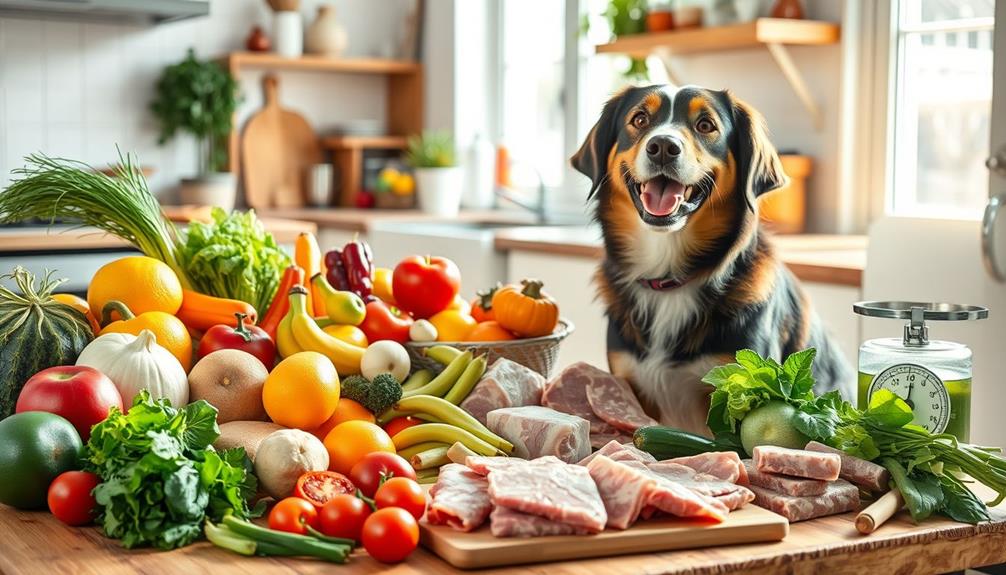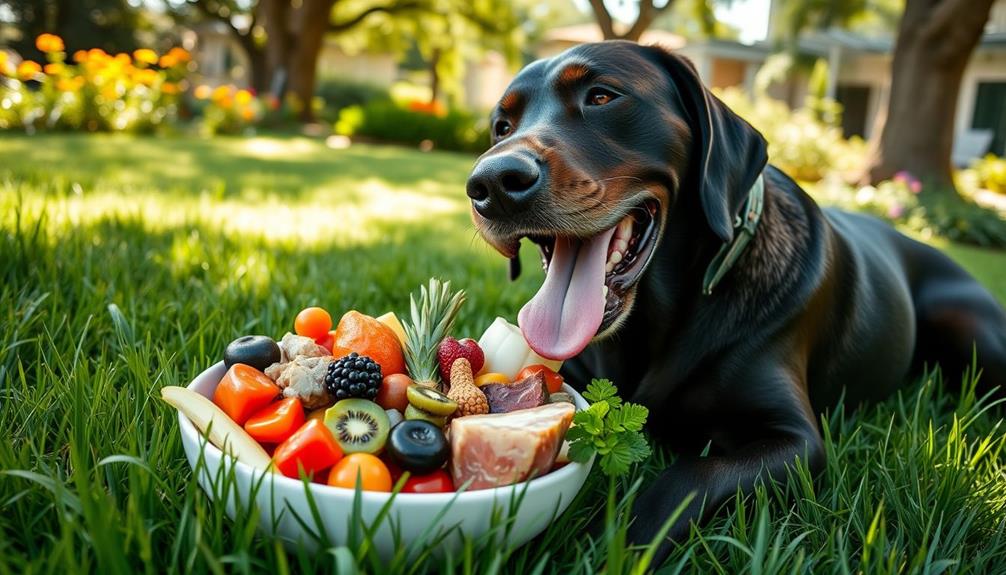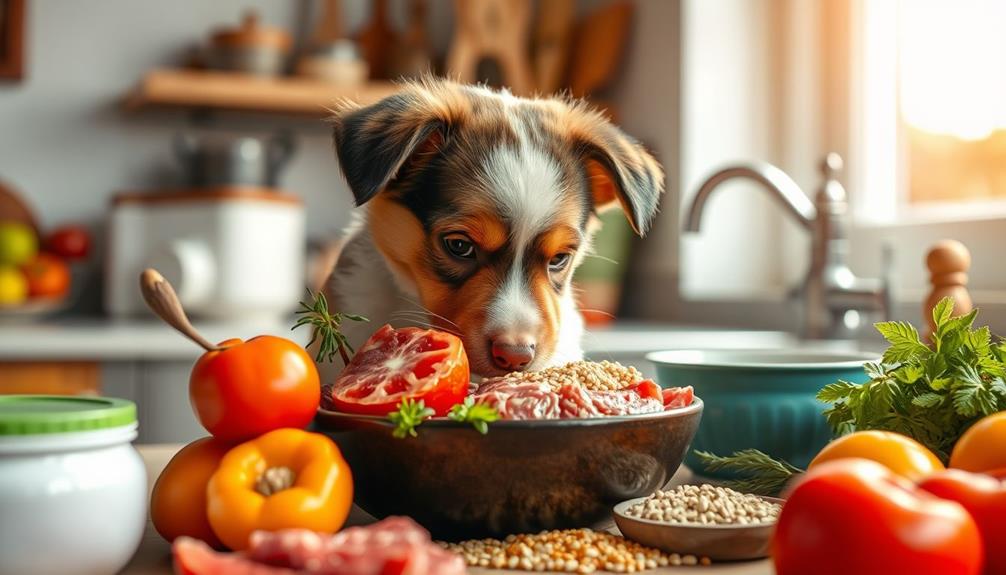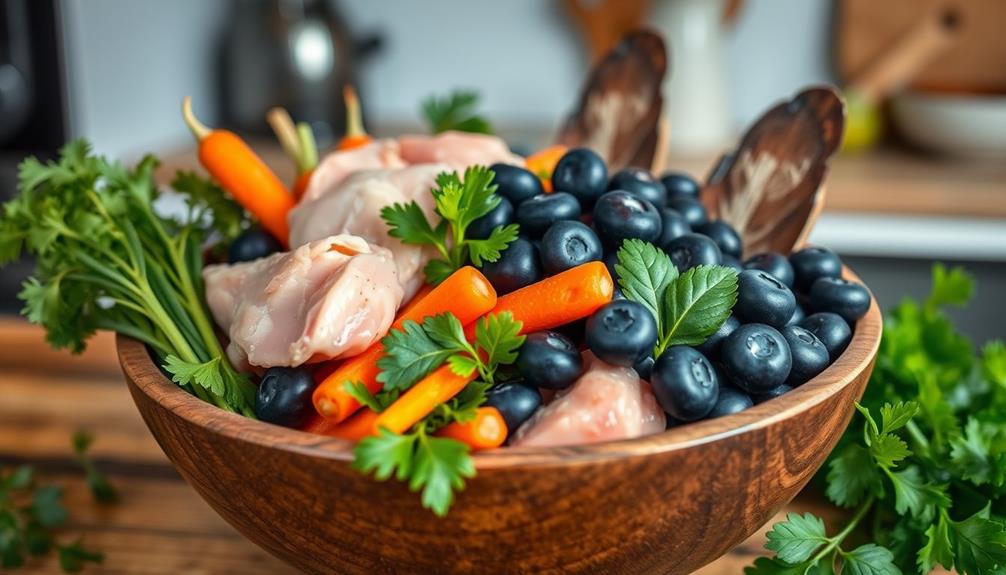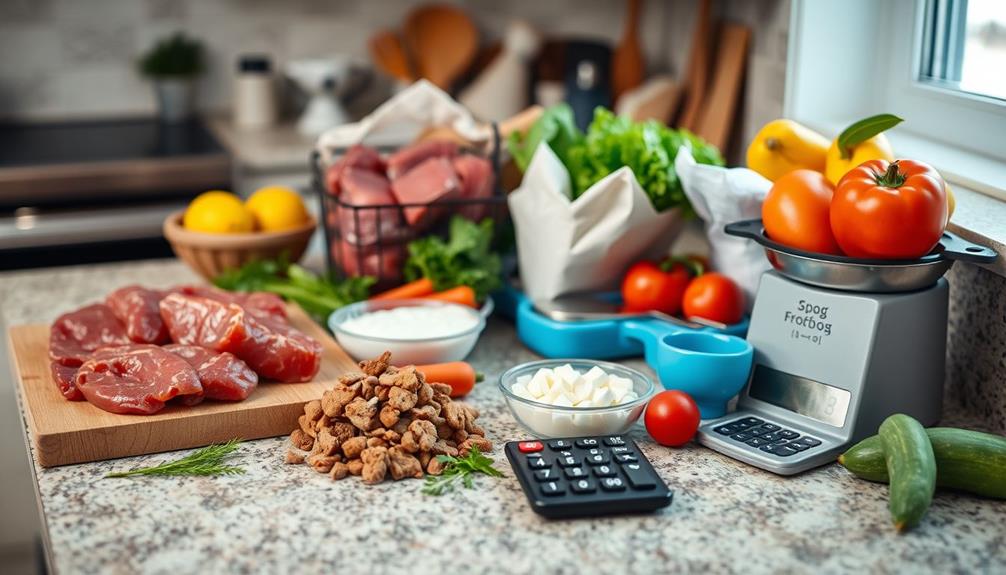When feeding your dog a raw food diet, aim for about 2-3% of their ideal body weight each day, divided into two meals. Active or underweight dogs may need up to 3%. Smaller breeds require slightly different amounts—5-6% for those under 5 lbs and 4-5% for those weighing 6-10 lbs. Start the shift gradually, mixing raw food with their current diet to prevent digestive upset. Always monitor your dog's weight and health, adjusting portions as needed. Choosing high-quality ingredients is also essential. There are more tips and insights to take into account for a successful raw feeding experience. It’s important to consult with a veterinarian before switching to a raw food diet for dogs, as they can provide guidance on the specific nutritional needs of your pet. Additionally, incorporating a variety of protein sources, such as beef, chicken, and fish, can help ensure that your dog receives all the necessary nutrients. Raw food diets for dogs can offer benefits such as improved digestion, healthier skin and coat, and increased energy levels when properly balanced and monitored. A common concern for pet owners is how much raw food to feed their dogs. It’s important to take into account factors such as their activity level, age, and any health conditions they may have. Monitoring your dog’s weight and energy levels can also help determine if they are getting the right amount of food. If you have any doubts or questions about how much raw food to feed your dog, don’t hesitate to reach out to a veterinarian or a pet nutritionist for personalized advice. Remember that every dog is unique, and their raw food diet should be tailored to their individual needs.
Key Takeaways
- Feed dogs 2-3% of their ideal body weight daily, split into two meals; active dogs may need up to 3%.
- Smaller dogs should receive 5-6% (up to 5 lbs) or 4-5% (6-10 lbs) of their body weight daily.
- Transition to raw food gradually, starting with 25% raw and increasing over 9 days to prevent digestive upset.
- Monitor weight, stool consistency, and energy levels during the transition for signs of adjustment or distress.
- Choose high-quality, hormone-free, and antibiotic-free ingredients for optimal nutrition and health benefits.
Benefits of a Raw Diet
A raw diet can offer several key benefits for your dog's health and well-being. By switching to a raw diet for dogs, you may notice improved digestion, which leads to better nutrient absorption and smaller, firmer poop. This not only makes cleanup easier but also indicates that your dog is utilizing their food efficiently.
Additionally, incorporating healthy dog snacks into your dog's diet can further enhance their overall wellness.
Furthermore, a raw diet can promote healthier skin and a shinier coat, thanks to the inclusion of healthy fats. You'll likely see fewer allergy symptoms, allowing your furry friend to feel more comfortable in their skin.
Plus, dogs on a raw diet often enjoy increased energy levels, contributing to a more active lifestyle.
Another advantage is better dental health; the natural chewing action involved with raw food helps reduce plaque and tartar buildup, keeping your dog's teeth cleaner.
Even if you introduce just 25% raw food into your dog's meals, you can experience significant health improvements.
Recommended Feeding Portions
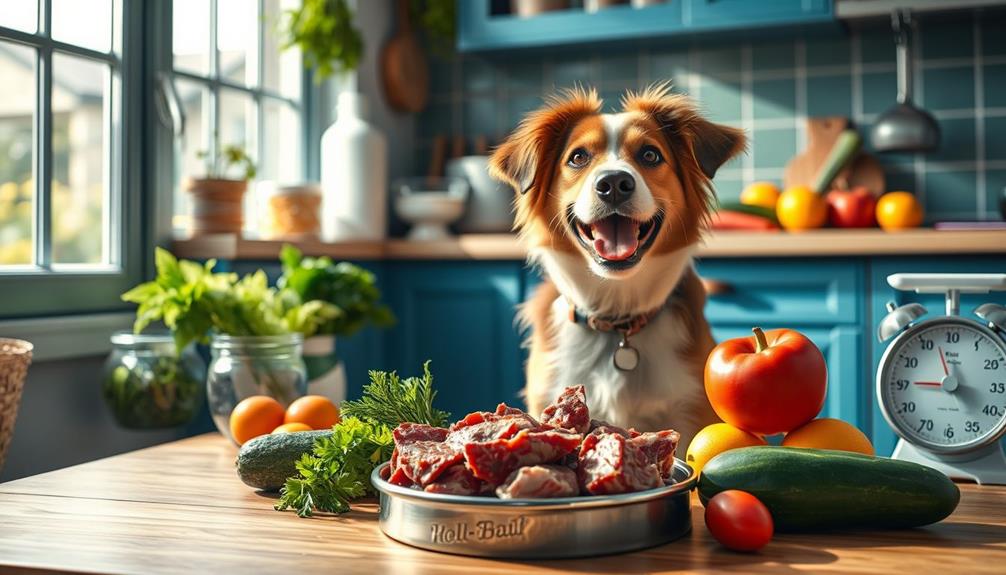
Determining the right portion size for your dog on a raw diet is vital for their health and well-being. Generally, the recommended feeding portions range from 2-3% of your dog's body weight each day, split into two meals. For instance, if your dog weighs 50 pounds, you'd need to provide about 1 to 1.5 pounds of raw food daily.
It's important to take into account your dog's overall health and activity level, as emotional and psychological support can also play a role in their eating habits. Active dogs or those that are underweight may require up to 3% of their ideal body weight, while less active dogs might do better with around 2%. For smaller dogs, it's slightly different: dogs weighing up to 5 lbs should get 5-6% of their body weight, whereas those weighing 6-10 lbs need about 4-5%.
It's imperative to monitor your dog's weight and health regularly. This way, you can make necessary adjustments to their food intake. If you notice weight gain or loss, think about tweaking the feeding amount accordingly.
Transitioning to Raw Food
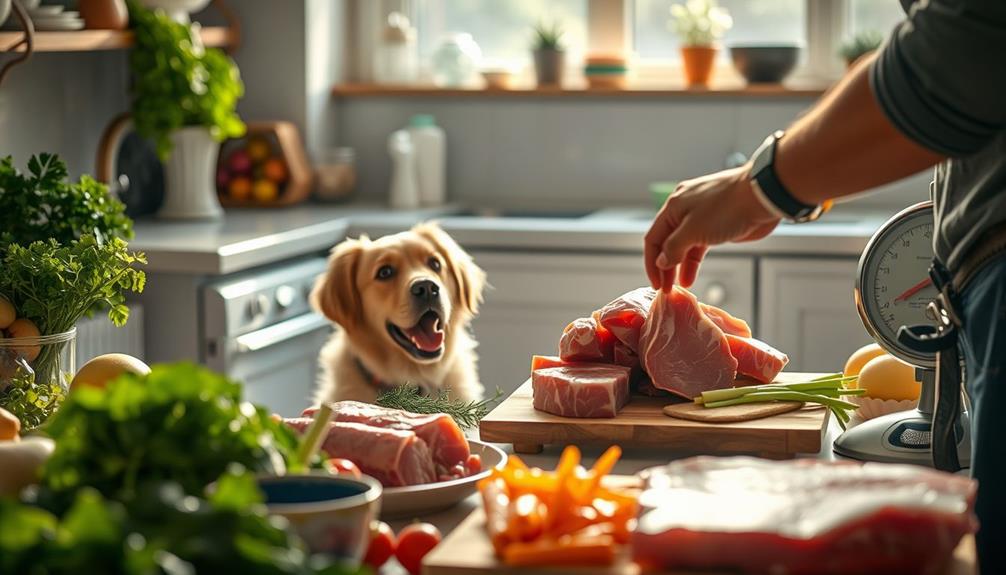
When shifting your dog to a raw food diet, start with a base mix of 25% raw and 75% of their current food for the first three days.
It's crucial to monitor their health closely during this process and adjust the mix as needed. A gradual shift helps prevent digestive upset and allows your dog to get used to the different textures and flavors of raw food.
For insights on proper diet guidelines, consider exploring resources that detail what constitutes a balanced meal for dogs.
Gradual Transition Process
Shifting your dog to a raw food diet should be a careful and gradual process to guarantee their digestive system adjusts smoothly.
It's essential to monitor your dog's reactions during this change, as some dogs may have sensitivities to new foods.
Start by mixing 25% raw food with 75% of your dog's current diet for the first three days. This gradual change process allows your dog to adapt without overwhelming their system.
After three days, increase the raw food proportion to 50% for the next three days, then to 75% raw food and 25% old diet for another three days.
For more tips on maintaining your dog's health, consider exploring cold medications overview.
Monitor Health Changes
As you shift your dog to a raw food diet, closely monitoring their health is essential to confirm they're adapting well. During this changeover, it's common for dogs to experience slight weight loss, primarily from water weight, which shouldn't exceed 1-2% of their body weight per week.
It's also important to be aware of any signs of emotional distress in your dog, as changes in diet can sometimes trigger anxiety or behavioral issues, similar to how individuals with Borderline Personality Disorder may react to environmental changes. Observe any changes in stool consistency and energy levels, as these indicators will help you gauge how well your dog is adjusting.
Gradually introducing the raw diet over about 10 days can minimize digestive issues. Start with 25% raw and 75% of their current diet, then increase the raw percentage.
Regularly assess your dog's weight and body condition, making necessary adjustments based on their activity level and overall health.
Consulting with a veterinarian during this changeover phase is highly recommended. They can provide personalized guidance, helping you make adjustments that prioritize your dog's health.
Start With Base Mix
Starting your dog on a raw food diet can be made easier by using a base mix to shift gradually. Incorporating essential oils for pet health can also support your dog's overall well-being during this change.
Begin the adjustment phase by mixing 25% raw food with 75% of your dog's current diet for the first three days. This helps your dog adjust without overwhelming their digestive system. After those initial days, increase the raw food percentage to 50% for the next three days, while monitoring your dog's weight and digestive health closely.
By Day 7, move to a 75% raw and 25% old diet for another three days. Finally, by Day 10, you can fully switch to a raw diet.
For puppies, start feeding them a raw food portion of 10% of their current weight, divided into 3-4 meals throughout the day during the adjustment.
Adjusting the proportions based on your dog's reaction is essential. If you notice any digestive issues or significant weight changes, don't hesitate to tweak the percentages until you find the right balance.
With careful monitoring and patience, your dog will smoothly change to their new raw food diet.
Quality of Ingredients
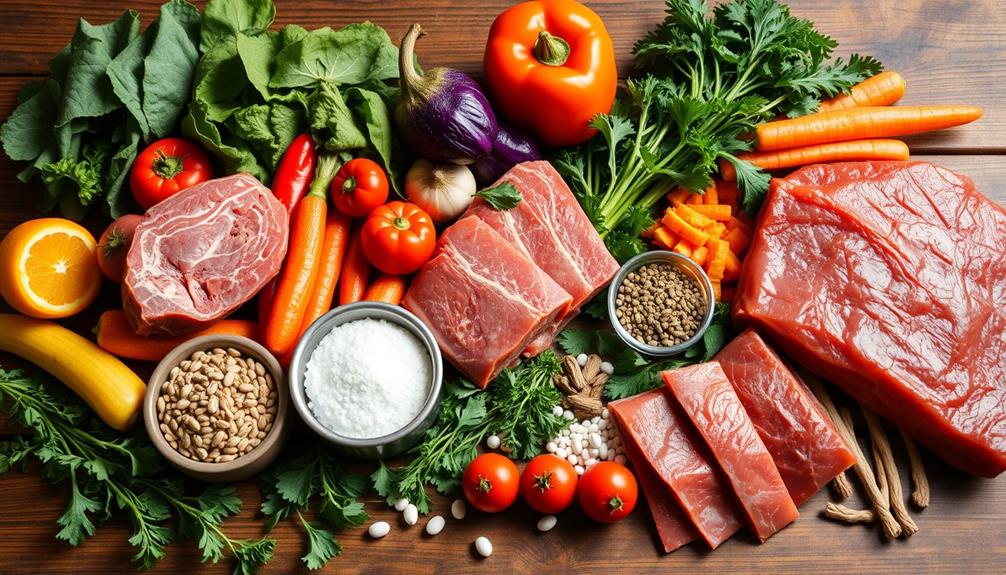
When it comes to feeding your dog raw food, the quality of ingredients matters greatly. You want to guarantee the meat and other components are locally sourced, hormone-free, and antibiotic-free for peak nutrition.
Additionally, ingredients rich in antioxidants, such as certain vegetables, can contribute to your dog's overall health, similar to the benefits of Cranberry Juice Consumption. This not only assures a balanced diet but also reflects the trustworthiness of the brand you choose.
Ingredient Sourcing Importance
Ingredient sourcing plays a significant role in the quality of raw dog food, directly affecting your pet's health and well-being. When you choose high-quality ingredients, like muscle meat and organ meat sourced without preservatives or artificial additives, you're ensuring a complete and balanced diet for your dog.
This is essential for ideal dog health, as the nutritional value of raw dog food hinges on the quality of its components. Just as the rich cultural heritage of the Hopi Tribe influences their sustainable practices, sourcing high-quality ingredients reflects a commitment to your dog's health and the environment.
Reputable brands prioritize transparency, maintaining trust by emphasizing their commitment to ingredient sourcing. Companies like We Feed Raw use USDA-certified human-grade ingredients, which not only enhance safety but also boost nutritional integrity.
These quality control measures during ingredient sourcing and preparation are critical for nutrient retention, allowing your dog to receive maximum health benefits from their diet.
Nutritional Balance Assurance
Achieving nutritional balance in your dog's raw diet hinges on including the right mix of muscle meat, organs, and finely ground bones. These components guarantee that your dog gets the essential vitamins and minerals needed for ideal health.
By emphasizing philosophical exploration in dietary choices, pet owners can better understand the importance of quality in their dog's nutrition. When you feed your dog a fully balanced raw diet, quality ingredients become paramount. Look for raw dog food that contains no fillers, preservatives, or artificial additives, focusing instead on whole, natural ingredients.
Ingredient sourcing plays a significant role in nutritional balance assurance. Choosing a company with a solid reputation for sourcing hormone-free and antibiotic-free meats can greatly enhance the quality of your dog's meals.
Regular quality control measures are essential to guarantee safety and consistency in raw dog food, maintaining the integrity of nutritional content.
Consider your dog's activity level when determining the amount of raw food to feed. Dogs with higher energy needs may require more protein and calories, while less active dogs may need less.
Feeding Raw Puppies

Feeding raw puppies requires careful attention to their unique nutritional needs. Puppies need a diet that supports their rapid growth and energy requirements, similar to how top gelato spots emphasize quality ingredients for peak flavor.
To guarantee they receive the right nutrition, follow these guidelines:
- Daily Amount: Feed your puppy at least 5% of their body weight daily, divided into 2-3 meals.
- Starting Point: Begin by offering 2-3% of their ideal adult weight or 10% of their current weight, and gradually introduce a variety of recipes.
- Monitor and Adjust: Keep an eye on your puppy's weight and adjust feeding amounts accordingly to guarantee healthy growth and prevent obesity.
A balanced raw diet for puppies should include muscle meat, organ meat, and bones to provide essential nutrients.
Additionally, consider adding beneficial supplements like fish oil, kefir, apple cider vinegar, and pre/probiotics as your puppy shifts to raw food. These elements will help support their overall health while they develop into strong, energetic dogs.
Choosing Raw Food Brands
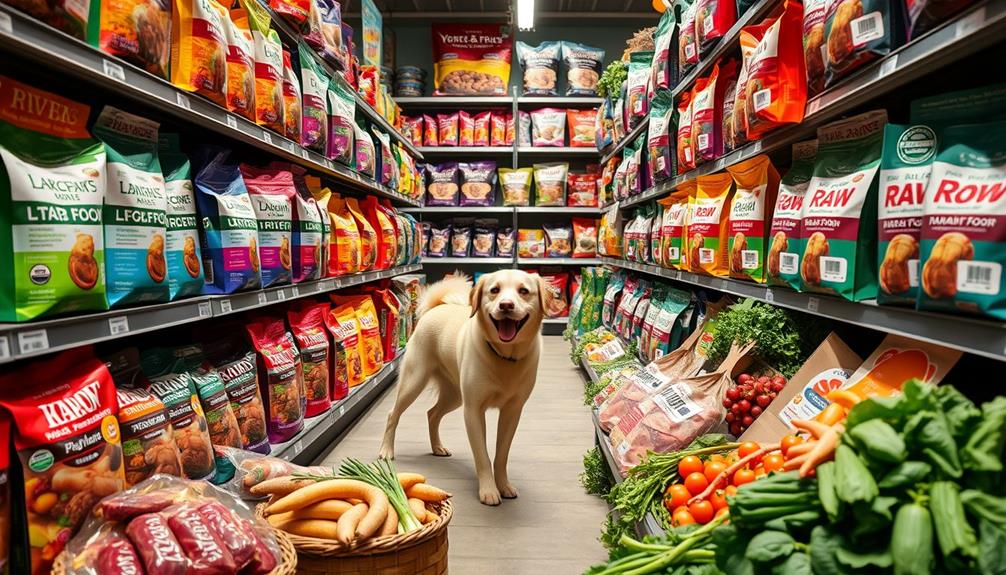
Choosing the right raw food brand for your dog is essential for ensuring they get the nutrition they need. Look for raw food brands that offer complete and balanced meals, which should include muscle meat, organ meat, and bone. This combination will help meet your dog's dietary needs effectively.
Transparency in ingredient sourcing is vital. Brands like We Feed Raw prioritize local sourcing and utilize hormone-free and antibiotic-free meats, avoiding fillers, preservatives, and artificial additives. Always check if the company adheres to AAFCO guidelines, as this confirms the food's nutritional adequacy.
Additionally, consider the quality control measures the brand employs. High-pressure processing (HPP) can enhance food safety without sacrificing nutritional value. A reputable brand will have stringent quality control practices in place.
Lastly, subscription services from trusted companies can make feeding your dog raw food easier. These services often offer convenient delivery options and customizable meal plans tailored to your dog's specific dietary needs, ensuring you always have fresh food on hand.
Frequently Asked Questions
How Much Raw Food Should I Feed My Dog Chart?
To determine how much raw food you should feed your dog, consider their ideal body weight, activity level, and health. Generally, aim for 2-3% of their weight daily, adjusting as needed for individual circumstances.
How Much Raw Should I Feed My Dog a Day?
You should feed your dog 2-3% of their ideal body weight daily, adjusting based on activity level. Monitor their weight regularly and use a calculator to guarantee you're providing the right amount.
What Is the 80 10 10 Rule for Raw Dog Food?
The 80 10 10 rule means you'll feed your dog 80% muscle meat, 10% organ meat, and 10% raw meaty bones. This balance guarantees they get essential nutrients for ideal health and energy.
What Is the Best Raw Food Ratio for Dogs?
You know what they say, "You are what you eat." For dogs, a good raw food ratio is 2-3% of their ideal weight, adjusting for activity level and health. Keep an eye on their condition!
Conclusion
Just like a garden flourishes with the right nutrients, your dog thrives on a balanced raw diet. By nurturing their health with quality ingredients and proper portions, you're planting seeds for a longer, happier life. Shifting slowly helps them adapt, much like a flower opens to the sun. As you choose the best brands, think of yourself as the gardener, cultivating well-being for your furry friend. With love and care, you'll reap the rewards of their health.

